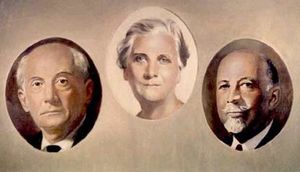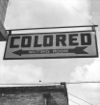الجمعية الوطنية للنهوض بالملونين
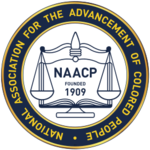 | |
| الاختصار | NAACP |
|---|---|
| التشكل | فبراير 12, 1909 |
| الغرض | "To ensure the political, educational, social, and economic equality of rights of all persons and to eliminate racial hatred and racial discrimination." |
| المقر الرئيسي | Baltimore, Maryland, U.S. |
الأعضاء | 300,000[1] |
Chairman | Leon W. Russell |
President & CEO | Derrick Johnson[2] |
الميزانية | $27,624,433[3] |
| الموقع الإلكتروني | naacp.org |
| مواضيع الأمريكان الأفارقة |
|---|
The National Association for the Advancement of Colored People (NAACP)[أ] is a civil rights organization in the United States, formed in 1909 as a bi-racial organization to advance justice for African Americans by W. E. B. Du Bois, Mary White Ovington and Moorfield Storey.[4]
Its mission in the 21st century is "to ensure the political, educational, social, and economic equality of rights of all persons and to eliminate race-based discrimination." Their national initiatives included political lobbying, publicity efforts, and litigation strategies developed by their legal team.[5] The group enlarged its mission in the late 20th century by considering issues such as police misconduct, the status of black foreign refugees, and questions of economic development.[6] Its name, retained in accordance with tradition, uses the once common term colored people, referring to people of some African ancestry.
The NAACP bestows annual awards to people of color in two categories: Image Awards are for achievement in the arts and entertainment, and Spingarn Medals are for outstanding achievement of any kind. Its headquarters is in Baltimore, Maryland.[7]
Predecessor: The Niagara Movement
In 1905, a group of thirty-two prominent African-American leaders met to discuss the challenges facing people of color and possible strategies and solutions.
التاريخ
Formation
The Race Riot of 1908 in Springfield, Illinois, the state capital and President Abraham Lincoln's hometown, was a catalyst showing the urgent need for an effective civil rights organization in the U.S. In the decades around the turn of the century, the rate of lynchings of blacks, particularly men, was at a high.
Jim Crow and disenfranchisement
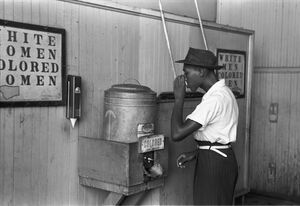
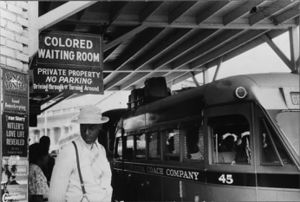
In its early years, the NAACP was based in New York City. It concentrated on litigation in efforts to overturn disenfranchisement of blacks, which had been established in every southern state by 1908, excluding most from the political system, and the Jim Crow statutes that legalized racial segregation.
Desegregation

The 1990s
In the 1990s, the NAACP ran into debt. The dismissal of two leading officials further added to the picture of an organization in deep crisis.
George W. Bush
See also
- African-American Civil Rights Movement (1896–1954)
- The Crisis, official magazine
- NAACP New Orleans Branch
- NAACP Theatre Awards
- NAACP Theatre Award – President's Award
- Niagara Movement
- Racial integration
== المراجع ==
- ^ NAACP is usually pronounced "N double-A C P."
- ^ naacp.org, August 4, 2011, "NAACP Passes Resolution Supporting Strong Clean Air Act". Accessed December 8, 2011.
- ^ http://www.naacp.org/latest/naacp-board-elects-derrick-johnson-president-ceo/
- ^ Charitynavigator.org
- ^ Kwame Anthony Appiah, Henry Louis Gates, Jr., eds. Africana: The Encyclopedia of the African and African American Experience, in articles "Civil Rights Movement" by Patricia Sullivan (pp 441-455) and "National Association for the Advancement of Colored People" by Kate Tuttle (pp 1,388-1,391). ISBN 0-465-00071-1.
- ^ "NAACP History and Geography". Mapping American Social Movements Through the 20th Century. University of Washington. Retrieved April 13, 2017.
- ^ "NAACP – Our Mission". Archived from the original on June 11, 2008. Retrieved September 5, 2008.
{{cite web}}: Unknown parameter|deadurl=ignored (|url-status=suggested) (help) - ^ "Contact Us". National Association for the Advancement of Colored People. Archived from the original on November 9, 2009. Retrieved November 17, 2009.
{{cite web}}: Unknown parameter|deadurl=ignored (|url-status=suggested) (help)
للاستزادة
- Alexander, Shawn Leigh. An Army of Lions: The Civil Rights Struggle Before the NAACP. (University of Pennsylvania Press, 2012).
- Berg, Manfred. The Ticket to Freedom: The NAACP and the Struggle for Black Political Integration (Univ. Press of Florida. 2007).
- Bynum, Thomas L. NAACP: Youth and the Fight for Black Freedom, 1936–1965. Knoxville, TN: University of Tennessee Press, 2013.
- Carle, Susan D. Defining the Struggle: National Racial Justice Organizing, 1880–1915 (Oxford UP, 2013). 404pp. focus on NAACP.
- Dalfiume, Richard. "The Forgotten Years of the Negro Revolution," Journal of American History 55 (June 1969): 99-100. fulltext in JSTOR
- Fleming, Cynthia Griggs. In the Shadow of Selma: The Continuing Struggle for Civil Rights in the Rural South. Rowman and Littlefield, 2004.
- Goings, Kenneth W. The NAACP Comes of Age: The Defeat of Judge John J. Parker. (1990).
- Hughes, Langston. Fight for Freedom: The Story of the NAACP. (1962)
- Janken, Kenneth Robert. White: The Biography of Walter White, Mr. NAACP. New York: The New Press, 2003.
- Jonas, Gilbert S. Freedom's Sword: The NAACP and the Struggle against Racism in America, 1909–1969. (Routledge, 2005).
- Kellogg, Charles Flint. NAACP: A History of the National Association for the Advancement of Colored People (Johns Hopkins UP, 1967).
- Lewis, David Levering. W.E.B. DuBois. In Two Volumes. (1994, 2001).
- Mosnier, L. Joseph. Crafting Law in the Second Reconstruction: Julius Chambers, the NAACP Legal Defense Fund, and Title VII. University of North Carolina, 2005.
- Reed, Christopher Robert. The Chicago NAACP and the Rise of Black Professional Leadership, 1910–1966 (Indiana UP, 1997).
- Ring, Natalie J. "National Association for the Advancement of Colored People" in Encyclopedia of American Studies, ed. Simon J. Bronner (Johns Hopkins University Press, 2015), online.
- Ross, Barbara Joyce. J. E. Spingarn and the Rise of the NAACP, 1911–1939. (1972)
- Ryan, Yvonne. Roy Wilkins: The Quiet Revolutionary and the NAACP. Lexington, KY: University Press of Kentucky, 2014.
- Sartain, Lee. Borders of Equality: The NAACP and the Baltimore Civil Rights Struggle, 1914–1970. (University Press of Mississippi, 2013).
- Sartain, Lee. Invisible Activists: Women of the Louisiana NAACP and the Struggle for Civil Rights, 1915–1945 (LSU Press 2007).
- St. James, Warren D. The National Association for the Advancement of Colored People: A Case Study in Pressure Groups. (1958)
- Schneider, Mark Robert. We Return Fighting: The Civil Rights Movement in the Jazz Age. Boston, MA: Northeastern University Press, 2001.
- Sullivan, Patricia. Lift Every Voice: The NAACP and the Making of the Civil Rights Movement. New York: The New Press, 2010.
- Thompson, Christina M. (2010). A More Perfect Union: Race, Rights, and Rhetoric in the NAACP and the White Citizens' Council. (M.A. thesis) Simmons College. OCLC 754658741.
- Topping, Simon; "'Supporting Our Friends and Defeating Our Enemies': Militancy and Nonpartisanship in the NAACP, 1936–1948," Journal of African American History, Vol. 89, 2004 in JSTOR
- Tushnet, Mark V. The NAACP's Legal Strategy against Segregated Education, 1925–1950 (U of N.C. Press 1987).
- Wedin, Carolyn. Inheritors of the Spirit: Mary White Ovington and the Founding of the NAACP (Wiley 1998).
- Woodley, Jenny. Art for Equality: The NAACP's Cultural Campaign for Civil Rights. Lexington, KY: University Press of Kentucky, 2014.
- Verney, Kevern and Lee Sartain (eds.), Long Is the Way and Hard: One Hundred Years of the NAACP. (2009).
- Zangrando, Robert. The NAACP Crusade Against Lynching, 1909–1950. Philadelphia, PA: Temple University Press, 1980.
وصلات خارجية
- Official website
- NAACP History and Geography
- Map of NAACP branches
- One Person, One Vote project
- Civil Rights Movement Veterans, crmvet.org
- Annual ACT-SO Contest, naacp-Los Angeles.org
- Official site of the Brooklyn, New York Branch, brooklynnaacp.org
- NAACP in Georgia, georgiaencyclopedia.org
- President Obama NAACP Speech: "Your Destiny Is In Your Hands … No Excuses" – video by The Huffington Post
- NAACP Turns 100: The History and Future of the Nation's Oldest and Largest Civil Rights Organization, democracywow.org video
- FBI file on the NAACP
Archives
- Overview of NAACP records at the Library of Congress, the official repository of the national organization
- NAACP branches database, including membership numbers and officer names. From the Mapping American Social Movements project at the University of Washington.
- Niagara Movement Du Bois Papers, Special Collections and University Archives, Umass Amherst
- National Association for the Advancement of Colored People, Region 1 Photograph Collection, ca. 1940–1982 at The Bancroft Library
- National Association for the Advancement of Colored People, Region I, Records, 1942–1986 (bulk 1945–1977) at The Bancroft Library
- National Association for the Advancement of Colored People, Vancouver Branch records. 1914–1967. 2.10 cubic feet (5 boxes). At the Labor Archives of Washington, University of Washington Libraries Special Collections
- NAACP Convention in Atlanta, Civil Rights Digital Library.
- CS1 errors: unsupported parameter
- Portal-inline template with redlinked portals
- Pages with empty portal template
- Articles with hatnote templates targeting a nonexistent page
- Official website different in Wikidata and Wikipedia
- National Association for the Advancement of Colored People
- Nonpartisan organizations in the United States
- Organizations based in Baltimore
- 1909 establishments in the United States
- منظمات تأسست في 1909
- Civil liberties advocacy groups in the United States
- African-American organizations
